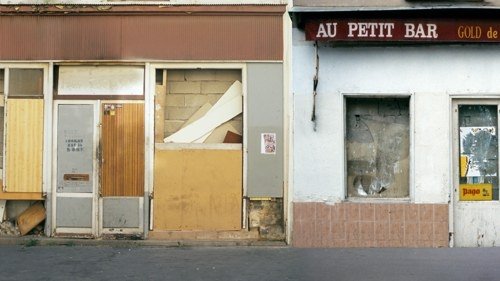Three exhibitions
dal 5/10/2009 al 24/10/2009
Segnalato da
5/10/2009
Three exhibitions
Kznsa Gallery, Durban
Poems for angel: new works by Andrew Verster / But I, I Will Not Return: a film installation by Marianne Halter / Chats: exploring sugars addition in Chatswoth.

POEMS FOR ANGELS: NEW WORK BY ANDREW VERSTER
“Angels are messengers. They bring good news and bad. They are, for me, a metaphor for our dreams, ambitions and aspirations and for our belief in something beyond the material. My angels are made of the most commonplace of materials, cardboard and paper, most of it recycled from packaging. There are two life-size standing figures made of unpainted corrugated cardboard and a series of cardboard and paper wings, stridently coloured in a way the classic white mythical angels never dreamed of. Somewhere in their construction lurks the craft of origami.” Andrew Verster
In addition, the artist has reconfigured his personal poetry into works of art. He writes that: “In 2006 I wrote a number of poems for reasons which I have now forgotten. I did the first on New Year’s Day and wrote another the next. By the end of a week it had become a daily habit. I continued through until the end of April, when I stopped. From these 120 poems, I have selected 19, each of which I have rendered in ink, and illustrated.”
............................
BUT I, I WILL NOT RETURN: A FILM INSTALLATION BYMARIANNE HALTER
But I, I Will Not Return deals with the loss of architecture and space (and thus a loss of memories and stories) whilst also examining the issue of access to housing. It’s a meditation on urbanity and our perception, on what is lost or transformed, thus begging the question of what will come afterwards.
Swiss artist Marianne Halter captured several photographs during a residency in Paris in 2003 which formed the starting material for a video-animation. These images were of houses with bricked-up windows and doors taken in the centre of Paris (thus, within the beltway that separates Paris from its outskirts). Several of these houses in Paris are still partly inhabited, the bricking-up and barricading is intended to keep squatters at bay, but simultaneously makes life difficult for the residents.
Halter started a methodical search of these buildings – often shop fronts – and photographed the ground floor under diffused light conditions. Thus began a kind of inventory where the artist found the complete infrastructure of a living city: hotels, restaurants, bars, laundries, pharmacies, upholsterers… Out of this material she composed a slow tracking shot along an endless row of houses, along the surface, hiding what is behind these walls. The loop, composed of many single shots meticulously assembled, functions as a densification and composition, shows us Paris how it is not while disclosing a state of being whose central significance is urban society. The musical accompaniment to the animation provides a certain dynamic and dramaturgy to contrast with the homogeny of the journey, creating a big-film feeling, within which nothing actually happens.
Marianne Halter (b. 1970) is a Swiss multi-media artist based in Zürich. She currently lectures at the Lucerne University of Arts and Design. She collaborates regularly with other artists in different disciplines, for example with the musician Mario Marchisella who composed and produced the soundtrack of the video-animation shown at KZNSA.
Halter has received various awards in Switzerland and has had residencies in Chicago, Paris and Johannesburg. Her work is represented in different public and corporate collections in Switzerland.
The artists are hosted at the KZNSA courtesy of ProHelvetia.
..........................
CHATS: EXPLORING SUGARS ADDICTION IN CHATSWORTH, DURBAN
“Sugars is a highly addictive mixture of cocaine and heroine of such low purity that it is often mixed with rat poison to assist it passing into the bloodstream. Its abuse has been concentrated among the Indian population (of Durban), while having little impact on the city’s African and white communities” (Reuters AlertNet, 17 May 2007).
Particularly prevalent in the Indian community of Chatsworth, Durban, the effects of the abuse of sugars has devastating effects on society, health, education and employment. Children, as young, as ten are often forced into dealing and prostitution to support their addiction.
In response to this reality, the KZNSA Gallery, in association with the National Lottery Distribution Trust Fund, embarked on a programme investigating the effect of the drug.
The exhibition has two components. The first component is based on photographic autobiographies of five young people from Chatsworth. For two months, guided by the programme’s curators, the young people examined themselves through self-portraiture, and documented their home and family life.
The second component is based on a series of audio interviews. Attempting to shed some light on the political and historic reasons behind the abuse of sugars are sociologist Dr Ashwin Desai; medical practitioner Dr Khorshed Ginwalla; academic, activist and author Professor Fatima Meer; and community worker Brandon Pillay. In addition, interviews with a sugars dealer, a very young woman currently serving a heavy sentence at Westville prison for drug-related offences, and a sex worker addicted to sugars, present a diverse series of observations and understandings of the root of the problems caused by the drug, and its devastating consequences.
The Programme is curated by Brenton Maart and Hemal Store-Shringla, and funded by the National Lottery Distribution Trust Fund.
Image: Marianne Halter (2008), Still 5
Single photograph from Aber ich, ich komm nicht mehr zurück (But I, I Will Not Return)
One-channel video with soundtrack by Mario Marchisella, Duration: 12’10’’ (looped).
Kznsa Gallery
Bulwer Road, Durban



